Why Not Visit the North Slope of Alaska?
The north slope of Alaska consists of all land north of the Brooks Mountain Range, which is itself over 200 miles north of Fairbanks. The north slope is comprised of tundra, slopes of hills or flat land covered in sponge-like brush and grasses.
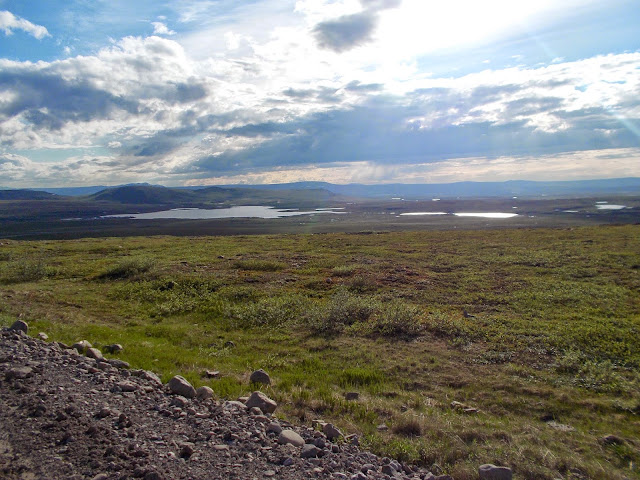 |
| The tundra of north slope Alaska, with the Brooks Range in the distance. |
Walking across the tundra is like walking through any wetland. One false step and water will unexpectedly fill a boot as it washes over the top edge of its water proof gortex. I visited the north slope of Alaska three times over the last four years to conduct scientific research on the methane cycle (
click here to read the study we published). We stayed at the Toolik Lake long term ecological research station. While the public cannot stay at the Toolik Lake facilities, I have met other travelers who visited the north slope with a tour company, such as the road scholars, or on their own by renting 4 wheel drive trucks in Fairbanks, and staying at small motels in Coldfoot and Dead Horse. The most accessible areas of the north slope are those along the Dalton Highway, and this is how we traveled to the north slope. The Dalton Highway is a mostly dirt, two lane road which parallels the Alaskan pipeline from Fairbanks to the oil town Dead Horse (also called Prudhoe Bay) on the Arctic Ocean. Unfortunately the Arctic Ocean cannot be reached at Dead horse, to see the ocean we had to travel to Barrow, Alaska, which will be covered in another post.
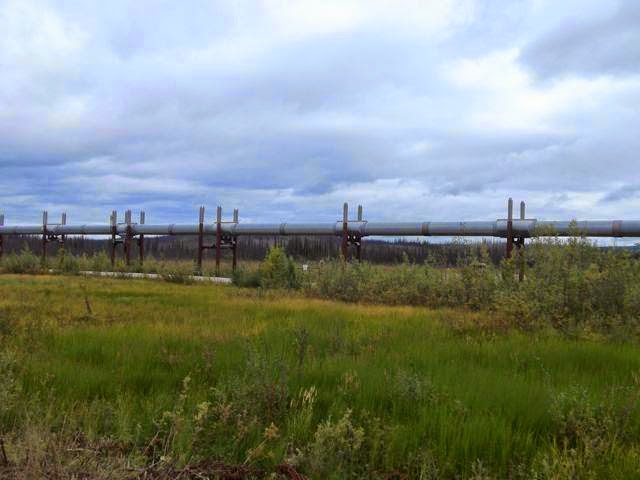 |
| The Alaskan pipeline that parallels the Dalton Highway from Fairbanks to Dead Horse. |
On the souther portion of the Dalton Highway, we saw forests turn to low shrubs, to tundra. The Dalton Highway also provides in its more southern portion access to Gates of the Arctic National Park. Visitors to Gates of the Arctic much hike in from the Dalton highway which boarders its eastern boundary or fly in. No infrastructure exists in this, America's northernmost, least visited, second largest national park.
 |
| A rare paved portion of the Dalton Highway adjacent to Gates of the Arctic National Park (left side of the road). |
Gates of the Arctic, along with most of Alaska's north slope, are encompassed within the Arctic Circle. The Bureau of Land Management (BLM) governs how most of the Arctic tundra in Alaska is used, whether for research, oil production, or as a natural reserve. For visitors to the north slope, the BLM has installed a sign at the location where the Dalton Highway crosses over into the Arctic Circle. We stopped and posed for photos at the sign each time we passed by on our multiple trips. On one occasion an employee of the BLM waited at the sign, handing out certificates for crossing the Arctic Circle for those who stopped for a photo.
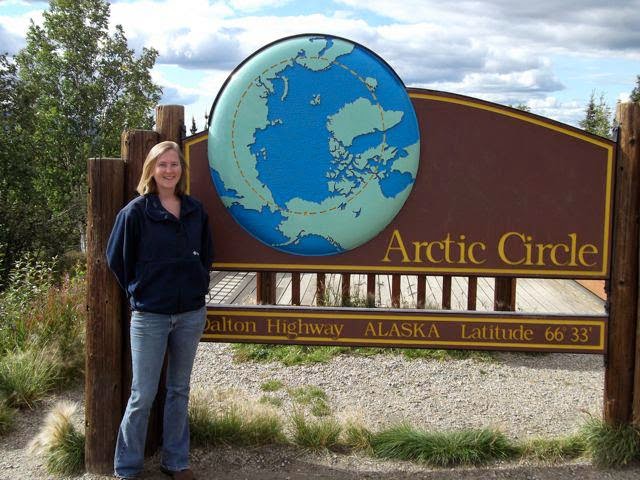 |
| Me posing at the Arctic Circle sign on the Dalton Highway. |
The main attraction aside from the Arctic Circle sign on the Dalton Highway is the plethora of wildlife. The tundra at first glance may seem devoid of much wildlife, but a closer look with a careful eye will reveal more than at first glance. Personally, in the tundra I have observed dall sheep, ptarmigan, ground squirrels, caribou, moose, arctic foxes, muskoxen, black bears, and Alaska's state bird the mosquito.
Many of these creatures are not familiar to those of us from the contiguous US. Dall sheep are large white sheep, which almost look like goats with a fur coat, because large round horns protrude from their forehead. Dall sheep blend in with the winter landscape, but in summer their white coats stand out against the green expanse. Ptarmigan are the tundra's version of a chicken. Often I would not see a ptarmigan until I stepped too close, and they ran away all in a fluster. Ptarmigan are not very smart, and I have heard a joke alluding that to live in the tundra, ptarmigans had to give up their brains. Caribou, also called reindeer, live all across Alaska in herds ranging from thousands to tens of thousands in number. They are also featured on most menus I have read in Alaska, and caribou sausages are sold from stands in downtown Anchorage. On my last trip we saw a caribou heard just an hour south of Deadhorse, with too many members to even guess the number.
Like caribou, moose can also be observed all across Alaska, especially at twilight when they are most active. I have observed moose standing in ponds eating the nutrient rich vegetation or meandering along the sides of roads, including the Dalton Highway, where the lack of trees makes their large bodies easy to spot. During the summer, most moose who dwell in the tundra migrate up into the Brooks Range, where cooler temperatures prevent mosquitos from venturing. Due to this habit, I have only seen one moose on the tundra, who was using the Dalton Highway as his own personal walking trail. We waited for him to move off of the road before continuing on with our journey.
Ground squirrels resemble fat prairie dogs, and may be my favorite animal of the tundra. Many researchers at the Toolik Lake research station study ground squirrels, because of their ability defy death. Ground squirrels hibernate by themselves in burrows in the tundra. They survive the winter by entering a deep hibernation where their heat beats only once or twice a minute and their body temperature drops to below freezing. The ground squirrels do not die though in their hypothermic state. They merely wait for spring to come. To keep their brain in good health, ground squirrels come out of their hibernation every few weeks to dream for a few hours before again lowering their body temperature to below freezing and slowing their heart rate. I have also seen a black bear (not be be confused with its larger cousin the grizzly bear also known as brown bear) sprinting away from the high way as our truck drove by. Black bears are generally more afraid of humans than brown bears, and would rather run away than charge or attack.
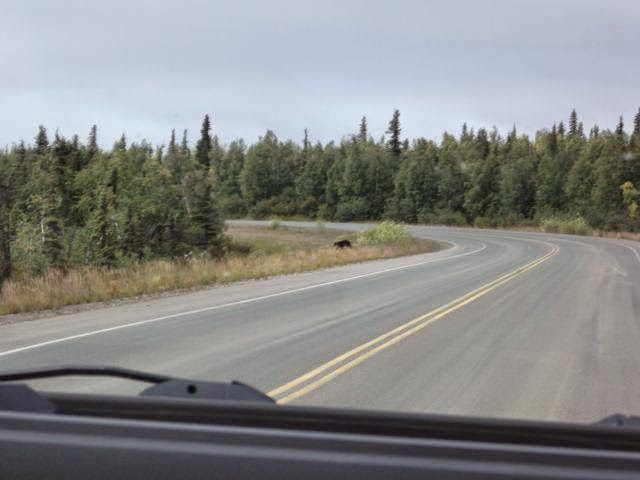 |
| A black bear sprinting away from our truck on the Dalton Highway. |
Arctic foxes are the primary road kill of the Dalton Highway, their bodies which were majestic in life, litter the highway. More than once while driving our research truck, I had to slam on the brakes as a fox darted across the road in front of me. Muskoxen are another odd animal only to be found in the tundra. These cow-like creatures with their long fur coats and curved horns roam the tundra in groups that can be observed from the Dalton Highway. They may even be smelled from the highway, as they are named for the strong musky odor emitted by males during the mating season.
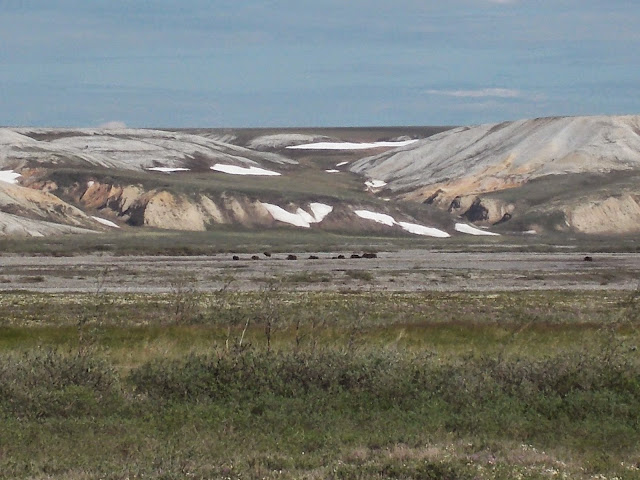 |
| Muskox along side the road of the Dalton Highway |
Lastly, a post about the north slope of Alaska would not be complete without a mention of the mosquito, which hatch in droves as soon as the air stops freezing at night. Walking across the tundra, I left no area of skin exposed. Thick snow pants, rain jackets, a head net, rubber gloves, and high hiking boots covered all of me. When mosquitos were at their worst every step resulted in an eruption of mosquitos form the tundra itself as they became aware of the presence of a potential meal. As long as I was completely covered I felt comfortable going about my day on the tundra, but if I relaxed too much and was negligent about my clothing, I would regret the mound of bites sure to follow.
 |
| Myself fully suited up to defend against the onslaught of mosquitos. |







I am so enjoying reading your blog. LOL, Terry
ReplyDelete